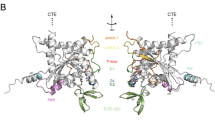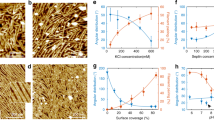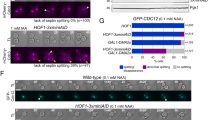Abstract
Septins are GTP-binding proteins that assemble into homo- and hetero-oligomers and filaments. Although they have key roles in various cellular processes, little is known concerning the structure of septin subunits or the organization and polarity of septin complexes. Here we present the structures of the human SEPT2 G domain and the heterotrimeric human SEPT2–SEPT6–SEPT7 complex. The structures reveal a universal bipolar polymer building block, composed of an extended G domain, which forms oligomers and filaments by conserved interactions between adjacent nucleotide-binding sites and/or the amino- and carboxy-terminal extensions. Unexpectedly, X-ray crystallography and electron microscopy showed that the predicted coiled coils are not involved in or required for complex and/or filament formation. The asymmetrical heterotrimers associate head-to-head to form a hexameric unit that is nonpolarized along the filament axis but is rotationally asymmetrical. The architecture of septin filaments differs fundamentally from that of other cytoskeletal structures.
This is a preview of subscription content, access via your institution
Access options
Subscribe to this journal
Receive 51 print issues and online access
$199.00 per year
only $3.90 per issue
Buy this article
- Purchase on SpringerLink
- Instant access to full article PDF
Prices may be subject to local taxes which are calculated during checkout




Similar content being viewed by others
References
Versele, M. & Thorner, J. Some assembly required: yeast septins provide the instruction manual. Trends Cell Biol. 15, 414–424 (2005)
Kinoshita, M. The septins. Genome Biol. 4, 236 (2003)
Byers, B. & Goetsch, L. A highly ordered ring of membrane-associated filaments in budding yeast. J. Cell Biol. 69, 717–721 (1976)
Haarer, B. K. & Pringle, J. R. Immunofluorescence localization of the Saccharomyces cerevisiae CDC12 gene product to the vicinity of the 10-nm filaments in the mother-bud neck. Mol. Cell. Biol. 7, 3678–3687 (1987)
DeMarini, D. J. et al. A septin-based hierarchy of proteins required for localized deposition of chitin in the Saccharomyces cerevisiae cell wall. J. Cell Biol. 139, 75–93 (1997)
Kozubowski, L. et al. A Bni4-Glc7 phosphatase complex that recruits chitin synthase to the site of bud emergence. Mol. Biol. Cell 14, 26–39 (2003)
Kinoshita, M. Assembly of mammalian septins. J. Biochem. 134, 491–496 (2003)
Macara, I. G. et al. Mammalian septins nomenclature. Mol. Biol. Cell 13, 4111–4113 (2002)
Hall, P. A., Jung, K., Hillan, K. J. & Russell, S. E. H. Expression profiling the human septin gene family. J. Pathol. 206, 269–278 (2005)
Kartmann, B. & Roth, D. Novel roles for mammalian septins: from vesicle trafficking to oncogenesis. J. Cell Sci. 114, 839–844 (2001)
Hall, P. A. & Russell, S. E. H. The pathobiology of the septin gene family. J. Pathol. 204, 489–505 (2004)
Kuhlenbaumer, G. et al. Mutations in SEPT9 cause hereditary neuralgic amyotrophy. Nature Genet. 37, 1044–1046 (2005)
Mitchison, T. J. & Field, C. M. Cytoskeleton: What does GTP do for septins? Curr. Biol. 12, R788–R790 (2002)
Kinoshita, M., Field, C. M., Coughlin, M. L., Straight, A. F. & Mitchison, T. J. Self- and actin-templated assembly of mammalian septins. Dev. Cell 3, 791–802 (2002)
Hsu, S. C. et al. Subunit composition, protein interactions, and structures of the mammalian brain sec6/8 complex and septin filaments. Neuron 20, 1111–1122 (1998)
Surka, M. C., Tsang, C. W. & Trimble, W. S. The mammalian septin MSF localizes with microtubules and is required for completion of cytokinesis. Mol. Biol. Cell 13, 3532–3545 (2002)
Joberty, G. et al. Borg proteins control septin organization and are negatively regulated by Cdc42. Nature Cell Biol. 3, 861–866 (2001)
Frazier, J. A. et al. Polymerization of purified yeast septins — evidence that organized filament arrays may not be required for septin function. J. Cell Biol. 143, 737–749 (1998)
Oegema, K., Desai, A., Won, M. L., Mitchison, T. J. & Field, C. M. Purification and assay of a septin complex from Drosophila embryos. Methods Enzymol. 298, 279–295 (1998)
Field, C. M. et al. A purified Drosophila septin complex forms filaments and exhibits GTPase activity. J. Cell Biol. 133, 605–616 (1996)
Vrabioiu, A. M., Gerber, S. A., Gygi, S. P., Field, C. M. & Mitchison, T. J. The majority of the Saccharomyces cerevisiae septin complexes do not exchange guanine nucleotides. J. Biol. Chem. 279, 3111–3118 (2004)
Farkasovsky, M., Herter, P., Voss, B. & Wittinghofer, A. Nucleotide binding and filament assembly of recombinant yeast septin complexes. Biol. Chem. 386, 643–656 (2005)
Sheffield, P. J. et al. Borg/septin interactions and the assembly of mammalian septin heterodimers, trimers, and filaments. J. Biol. Chem. 278, 3483–3488 (2003)
Nguyen, T. Q., Sawa, H., Okano, H. & White, J. G. The C. elegans septin genes, unc-59 and unc-61, are required for normal postembryonic cytokineses and morphogenesis but have no essential function in embryogenesis. J. Cell Sci. 113, 3825–3837 (2000)
Mendoza, M., Hyman, A. A. & Glotzer, M. GTP binding induces filament assembly of a recombinant septin. Curr. Biol. 12, 1858–1863 (2002)
Huang, Y. W., Surka, M. C., Reynaud, D., Pace-Asciak, C. & Trimble, W. S. GTP binding and hydrolysis kinetics of human septin 2. FEBS J. 273, 3248–3260 (2006)
Leipe, D. D., Wolf, Y. I., Koonin, E. V. & Aravind, L. Classification and evolution of P-loop GTPases and related ATPases. J. Mol. Biol. 317, 41–72 (2002)
Scrima, A. & Wittinghofer, A. Dimerisation-dependent GTPase reaction of MnmE: how potassium acts as GTPase-activating element. EMBO J. 25, 2940–2951 (2006)
Gasper, R., Scrima, A. & Wittinghofer, A. Structural insights into HypB, a GTP-binding protein that regulates metal binding. J. Biol. Chem. 281, 27492–27502 (2006)
Low, C. & Macara, I. G. Structural analysis of septin 2, 6, and 7 complexes. J. Biol. Chem. 281, 30697–30706 (2006)
Boehringer, D. et al. Three-dimensional structure of a pre-catalytic human spliceosomal complex B. Nature Struct. Mol. Biol. 11, 463–468 (2004)
van Heel, M. & Frank, J. Use of multivariate statistics in analysing the images of biological macromolecules. Ultramicroscopy 6, 187–194 (1981)
Chant, J. Septin scaffolds and cleavage planes in Saccharomyces. Cell 84, 187–190 (1996)
Vrabioiu, A. M. & Mitchison, T. J. Structural insights into yeast septin organization from polarized fluorescence microscopy. Nature 443, 466–469 (2006)
Kabsch, W. Automatic processing of rotation diffraction data from crystals of initially unknown symmetry and cell constants. J. Appl. Cryst. 26, 795–800 (1993)
Schneider, T. R. & Sheldrick, G. M. Substructure solution with SHELXD.. Acta Crystallogr D 58, 1772–1779 (2002)
Terwilliger, T. C. SOLVE and RESOLVE: automated structure solution and density modification. Methods Enzymol. 374, 22–37 (2003)
CCP4. The CCP4 (Collaborative Computational Project Number 4) suite: programs for protein crystallography. Acta Crystallogr. D 50, 760–763 (1994)
Emsley, P. &. Cowtan, K. Coot: Model-building tools for molecular graphics. Acta Crystallogr. D 60, 2126–2132 (2004)
Murshudov, G. N., Vagin, A. A. & Dodson, E. J. Refinement of macromolecular structures by the maximum-likelihood method. Acta Crystallogr. D 53, 240–255 (1997)
Brunger, A. T. et al. Crystallography & NMR system: A new software suite for macromolecular structure determination. Acta Crystallogr. D 54, 905–921 (1998)
DeLano, W. L. The PyMOL Molecular Graphics System 〈http://www.pymol.org 〉 (2006)
Dube, P., Tavares, P., Lurz, R. & van Heel, M. The portal protein of bacteriophage SPP1: a DNA pump with 13-fold symmetry. EMBO J. 12, 1303–1309 (1993)
van Heel, M. & Frank, J. Use of multivariate statistics in analysing the images of biological macromolecules. Ultramicroscopy 6, 187–194 (1981)
van Heel, M. Classification of very large electron microscopical image data sets. Opik 82, 114–126 (1989)
Sander, B., Golas, M. M. & Stark, H. Corrim-based alignment for improved speed in single-particle image processing. J. Struct. Biol. 143, 219–228 (2003)
van Heel, M., Harauz, G., Orlova, E. V., Schmidt, R. & Schatz, M. A new generation of the IMAGIC image processing system. J. Struct. Biol. 116, 17–24 (1996)
Acknowledgements
Data collection was done at the Swiss Light Source, beam line X10SA, Paul Scherrer Institute, Villigen, Switzerland, and we thank the beam line staff for assistance. We would like to thank I. Vetter, I. Schlichting, T. Meinhart, W. Blankenfeldt, N. Schrader, E. Hofmann, K. Kühnel, A. Scrima, R. Gasper and R. Rose for data collection and crystallographic advice. M.S. and F.H. thank the International Max Planck Research School for financial support. This work was supported by the 3D Repertoire project, within the EU Sixth Framework Program, and the Fondation Louis-Jeantet.
Author Contributions M.S. purified and crystallized SEPT2-315 and the human septin complex and solved the structures. M.F. made the human septin complex constructs, developed the purification procedure and purified the yeast septin complex used in the electron microscopy. F.H. and H.S. did the electron microscopy analysis. D.K. made SEPT2-315 mutants. M.W. assisted M.S. throughout data collection and structure determination. I.G.M. provided the clones for human septins, and valuable hints. A.W. supervised the project and wrote the paper. All authors discussed the results and commented on the manuscript.
The atomic coordinates of SEPT2-315 and the human septin complex are deposited in the Protein Data Bank with accession numbers 2QA5 and 2QAG, respectively.
Author information
Authors and Affiliations
Corresponding author
Ethics declarations
Competing interests
Reprints and permissions information is available at www.nature.com/reprints. The authors declare no competing financial interests.
Supplementary information
Supplementary Information
This file contains Supplementary Tables 1-4 describing the data collection, phasing, and refinement statistics and EM particle statistics, Supplementary Figures 1-3 with Legends showing sequence alignment of Sept2, 6 and 7 with secondary structural elements; details of Sept2 interface and raw electron density pictures of HSC. (PDF 569 kb)
Rights and permissions
About this article
Cite this article
Sirajuddin, M., Farkasovsky, M., Hauer, F. et al. Structural insight into filament formation by mammalian septins. Nature 449, 311–315 (2007). https://doi.org/10.1038/nature06052
Received:
Accepted:
Published:
Issue Date:
DOI: https://doi.org/10.1038/nature06052



